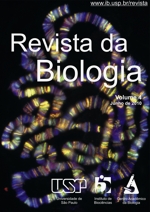Aspectos evolutivos do splicing alternativo
DOI:
https://doi.org/10.11606/issn.1984-5154.v4p44-49Palavras-chave:
Splicing alternativo, exons, EST, diversidade.Resumo
Os eucariotos apresentam mecanismos muito refinados para o controle de sua expressão gênica, dentre eles, o splicing alternativo. Este mecanismo, abundante entre estes organismos, possibilita a geração de diferentes proteínas a partir de um único gene. Esta revisão pretende mostrar como as características do splicing alternativo podem torná-lo uma ferramenta interessante em estudos com enfoque evolutivo, em questões envolvendo tanto o surgimento do mecanismo quanto sua atuação na diversificação dos seres vivos.
Downloads
Referências
Abril, J. F., Castelo, R., Guigó, R. (2005). Comparison of splice sites in mammals and chicken. Genome Research. 15(1), 111-119.
Alberts, B., Johnson, A., Lewis, J., Raff, M., Roberts, K., Walter, P. (2002). Biologia Molecular da Célula (4a Ed.). Editora Artes Médicas, Porto Alegre, RS.
Ast, G. (2004). How did alternative splicing evolve? Nature Review Genetics. 5(10), 773-782.
Blencowe, B.J. (2006). Alternative splicing: New insights from global analysis. Cell. 126(1), 37-47.
Boue,S., Letunic, I., Bork, P. (2003). Alternative splicing and evolution. Bioessays. 25(11), 1031-1034.
Burge, C., Tuschl, T., Sharp, P.A. (1999). Splicing of precursors to mRNAs by the spliceosomes. P. 525-529. In: Gesteland, R.F.; Cech, T.R.; Atkins, J.F. (eds). 1999. The RNA World, Cold Spring Harbor Press, New York.
Brett, D., Pospisil, H., Valcárcel, J., Reich, J., Bork, P. (2002). Alternative splicing and genome complexity. Nature Genetics. 30(1), 29 – 30.
Copley, R.R. (2008). The animal in the genome: comparative genomics and evolution. Philosophical Transactions of The Royal Society. 363(1496), 1453-1461.
Ferreira, E.N., Galante, P.A.F., Carraro, D.M., de Souza, S.J. (2007). Alternative splicing: a bioinformatics perspective Molecular bioSystems 3(7), 473-477.
Herbert, A. e Rich, A. (1999). RNA processing and the evolution of eukaryotes. Nature Genetics. 21(3), 265-269.
Harrington, E.D., Boue, S., Valcarcel, J., Reich, J.G., Bork, P. (2004). Estimating rates of alternative splicing in mammals and invertebrates. Nature Genetics. 36(9), 915–916; author reply, 916–917.
Irrina, M., Rukov, J.L., Roy, S.W., Vinther, J., Garcia-Fernandez, J. (2009). Quantitative regulation of alternative splicing in evolution and development. Bioessays. 31(1), 40-50.
Johnson, J.M., Castle, J., Garrett-Engele, P., Kan, Z., Loerch, P.M., Armour, C.D., Santos, R., Schdat, S.E., Stoughton, R., Shoemaker, D.D. (2003). Genome-wide survey of human alternative pre-mRNA splicing with exon junction microarrays. Science, 302(5653), 2141-2144.
Kim, H., Majewski, R.K.J., Ott, J. (2004). Estimating rates of alternative splicing in mammals and invertebrates.Nature Genetics. 36(9), 915 – 916; author reply, 916-917.
Kim, E., Goren, A., Ast, G. (2007a). Alternative splicing: current perspectives. BioEssays. 30(1), 38-47.
Kim, E., Magen, A., Ast, G. (2007b). Different levels of alternative splicing among eukaryotes. Nucleic Acids Research. 35(1), 125–131.
Kondrashov, F.A., Koonin, E.V. (2003). Evolution of alternative splicing: deletions, insertions and origin of functional parts of proteins from intron sequences. Trends in genetics. 19(3),115-119.
Lareau, L.F., Green, R.E., Bhatnagar, R.S., Brenner, S.E. (2004). The evolving roles of alternative splicing. Current Opinion in Structural Biology.14(3), 273–282.
Letunic, I., Copley, R.R., Bork, P. (2002). Common exon duplication in animals and its role in alternative splicing. Human Molecular Genetics. 11(13), 1561–1567.
Lev-Maor, G., Goren, A., Sela, N., Kim, E., Keren, H., Doron-Faigenboim, A., Leibman-Barak, S., Pupko, T., Ast, G. (2007). The “alternative” choice of constitutive exons throughout evolution. Plos Genetics. 3(11), e203.
Liu, C., Bai, B., Skogerbø, G., Cai, L., Deng, W., Zhang, Y., Bu, D., Zhao, Y., Chen, R. (2005). NONCODE: an integrated knowledge database of non-coding RNAs Nucleic Acid Research. 33(database issue), D112-D115.
Modrek, B. e Lee, C.J. (2002). A genomic view of alternative splicing. Nature Genetics. 30(1), 13-19.
Modrek, B. e Lee, C.J. (2003). Alternative splicing in the human, mouse and rat genomes is associated with an increased frequency of exon creation and/or loss. Nature Genetics. 34(2), 177-180.
Sharp, P.A. (2009). The Centrality of RNA. Cell, 136(4), 577- 580.
Su, Z., Wang, J.,Yu,J., Huang, X., Gu, X. (2006). Evolution of alternative splicing after gene duplication. Genome Research. 16(2), 182-189.
Wang, E.T., Sandberg, R., Luo, S., Khrebtukova, I., Zhang, L., Mayr, C., Kingsmore, S. F., Schroth, G.P., Burge, C.B. (2008). Alternative isoform regulation in human tissue transcriptomes. Nature. 456(7221), 470-476.
Xing, Y., Lee, C. (2005). Evidence of functional selection pressure for alternative splicing events that accelerate evolution of protein subsequences. PNAS. 102(38), 13526–13531.
Xing, Y., Lee, C. (2006). Alternative splicing and RNA selection pressure-evolutionary consequences for eukaryotic genomes. Nature Reviews Genetics. 7(7), 499-509.
Zhang, X.H.F. e Chasin, L.A. (2006). Comparison of multiple vertebrate genomes reveals the birth and evolution of human exons. PNAS. 103(36), 13427–13432.
Downloads
Publicado
Edição
Seção
Licença
Copyright (c) 2010 Barbara Mizumo Tomotani

Este trabalho está licenciado sob uma licença Creative Commons Attribution 4.0 International License.
Salientamos que nossa revista não detém copyright, estes são exclusivos do autor do texto. Pretendemos com isso não criar entraves ao acesso do material publicado e atingir com mais intensidade nosso objetivo de divulgação da ciência.








 revistadabiologia@ib.usp.br
revistadabiologia@ib.usp.br 2008 - 2024 Revista da Biologia
2008 - 2024 Revista da Biologia